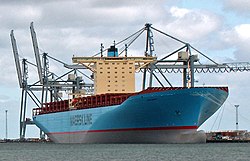This article needs additional citations for verification .(June 2025) |
This is a list of container ships, both those in service and those which have ceased to operate. Container ships are a type of cargo ship that transports containers. For ships that have sailed under multiple names, their most recent name is used and former names are listed in the Notes section.





























